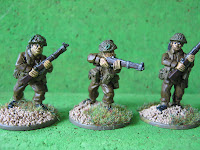 |
| Late War British Officers |
The Brits are going to war!
At least some of them are. I've recently finished a
painting commission to paint some Late War British WW2 figures. They are all from
Crusader Miniatures and were really nice to paint. All the castings and details were crisp and the Vallejo paint went on a treat.
They were actually a commission for my father who has, like many at The October Wargames club, become interested in a set of wargames rules called
Operation Squad by Massimo Torriani and Valentino Del Castello. As you can tell from their names these are Italian chaps and they have put together are really nice, simple set of World War Two rules for games at a squad level.
Rather than an I-Go-You-Go system it uses a reaction based system and the turn sequence goes as follows:
1) Inititive. Each player rolls two six sided and adds the Tactical Value of their highest figure. The Tactical Value is the general ability level of the figure. Average troops have a Tactical Value of 3 while as more elite troops such as commandos and paratroopers have a Tactical Value of 4. The winner can choose to move first or second. The person who goes first has the initiative (Player A).
2) Action Sequence:
 |
| Late War British Riflemen |
|
- Player A selects one of his men and declares his intentions - Move and Fire, Fire, Reload, Move Carefully, Run are just some of the actions a figure can perform. If moving you declare where the figure is moving to.
- Player B can now react. He declares the intentions for one of his men in a similar way.
Once each player as declared intentions for three figures, the players roll 2D6 and add the Tactical Value for each figure acting. Actions are then performed from the highest to the lowest.
The sequence then begins again starting with Player B declaring the action for one of his figures.
This is them repeated until all figures have acted, at which point a new turn begins.
The sequence is a bit more in depth than this but hopefully this conveys the gist of it.
 |
| German Grenadier with MG42 LMG |
Combat is simple. When declaring a Fire or Move and Fire action you pick a target, then measure the range. The shooting players rolls 3D6 adding any dice for range modifiers (for a Lee Enfield rifle at upto 40 cm add 1D6, for an MP40 at up to 20cm add 2D6). The shooter also adds the figures Tactical Value. The defender rolls a number of D6 depending on the situation. For example if the target figure is in woods he rolls 2D6 as a cover bonus, if the target figure also ran in its previous action add another D6.
The dice are then rolled. The defenders total is subtracted from the attackers total. If the result is 11-13 the target is pinned, 14-15 the target is wounded and 16 or more KIA.
And that is the basics of the system.
The basic rulebook has three lists each for the American, British, Germans and Russians and all are based around a single squad with options. On average you will play with about 10 figures in a game. There are also six scenarios from a recon mission to capturing documents from an abandoned vehicle in the middle of the table.
There are also two expansion books - Vehicles (which adds vehicles and new lists) and Reinforcements (which adds some more vehicles, lists and scenarios). I've not played with any of the material out of these books so I can't comment on how they play.

